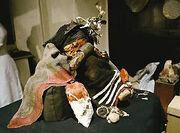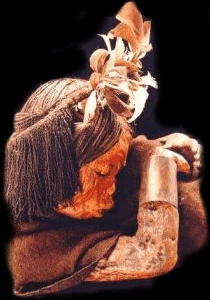(some of the text) Tags: Visual edit apiedit |
No edit summary |
||
| (10 intermediate revisions by 3 users not shown) | |||
| Line 1: | Line 1: | ||
| + | {{Infobox_humanmummy |
||
| − | {{Navbox |
||
| ⚫ | |||
| − | |header = Contents |
||
| + | | image =0dec02c07e.gif| |
||
| − | |body = Biography |
||
| + | |name = El Plomo Boy, Boy of El Plomo, El Plomo Mummy, La Momia del Cerro El Plomo |
||
| − | |||
| − | References}} {{Infobox_humanmummy |
||
| ⚫ | |||
| − | |name = The El Plomo Boy |
||
|age = 8 |
|age = 8 |
||
|sex = Male |
|sex = Male |
||
| Line 14: | Line 11: | ||
|site = Cerro El Plomo |
|site = Cerro El Plomo |
||
|location = National Museum of Natural History, Santiago Chile |
|location = National Museum of Natural History, Santiago Chile |
||
| + | |catalogue = Unknown }}El Plomo boy is an Incan mummy discovered in 1954 by a group of climbers at the summit of Cerro El Plomo in Chile. The mummy is approximately 500 years old, the boy was approximately 5-8 at the time of death. The cold climate and minimal rain fall atop the mountain allowed the mummy to remain remarkably well preserved. |
||
| − | |catalogue = Unknown }} |
||
| − | |||
| − | '''Biography''' |
||
| − | |||
| ⚫ | |||
| − | |||
| − | [[File:0dec02c07e.gif|thumb|left|The El Plomo is remarkably well preserved. ]] |
||
| ⚫ | The mummy was well dressed in Incan textiles and jewelry, and found with a gold llama, a silver doll, and pouches containing his baby teeth and nail clippings. In addition, his hair was braided into 200 intricate strands. El Plomo boy was the first mummy discovered in a series that would later reveal the Incan practice of sacrificing children to the gods that they believed to control water. |
||
| ⚫ | The Andean mountains were a key part of the Incan kingdom, which stretched from |
||
| + | ==Studies== |
||
| + | The distinctive red and yellow bands painted across the child's face are composed of iron ochre and arsenic sulfides mixed with animal fats, respectively.[[File:d7c24270e0.jpg|thumb|left]] |
||
| + | The mummy was also surrounded with grave goods consisting of nail clippings, animal organs, deciduous teeth and hair. His clothes included a tunic made from black llama wool with fringes of dyed red llama wool along the edges, leather moccasins with red trimmings, a grey alpaca fur shawl that was also trimmed with red and plaited hair that was held with a headband tied together at the chin along with a woolen headdress. A silver bracelet on the left forearm and an H-shaped pectoral accessory that hung from his neck, two signs of high social class in the Inca culture. |
||
| − | [[File:Horizon Ice Mummies - Frozen In Heaven|thumb|right|345px|See 12:20 for discussion of the El Plomo Boy. ]] |
||
| + | ==Pathology== |
||
| − | Human sacrifice was not common amongst the Inca, but the need to appease mountain Gods controlling rain and water was believed to be critical to the survival of the Incan people. Accounts of Capa Cocha first appeared in Spanish chronicles, though it was ethnocentrically depicted as a bloody and savage ritual. During the Capa Cocha ritual a child would be brought to the empire's capital of Cuzco, blessed by the emperor, then paraded through the kingdom in a ritual procession until they reached the top of the mountain on which they were sacrificed and buried. Children selected for sacrifice were considered pure and perfect, and it was believed they would be deified in death. Analysis of stomach and intestinal contents of some of these mummies indicates that they were sedated before death with the use of coca leaves and chica, a maize beer. In the case of the El Plomo boy, his peacful expression indicates he passed peacefully from sleep to death. P.D. Horn, from the University of Toronto's Anthropology Department, noted in 1982 the distinctive red and yellow bands painted across the child's face composed of iron ochre and arsenic sulphides mixed with animal fats, respectively. The distinctive smell of the mummy, caused by changes in body fat, attests to its good condition. |
||
| + | There were no lesions, growth arrests or injuries found on the boy's body and there were no infections on the superficial tissues of the mummy's skin. During the examination there was indications that the boy had ''Trichuris trichiura'' (human whipworm) and found nits of ''Pediculus humanis capitis'' in his hair. Further studies showed that he had the papilloma virus and angiokeratoma, and had type O blood type. Upon discovery, weighed 35 kilos. |
||
| + | ==Additional== |
||
| ⚫ | |||
| ⚫ | The Andean mountains were a key part of the Incan kingdom, which stretched from Ecuador to southern Chile. The Inca believed the summit of a mountain served as a ladder to heaven, making these sites important sacred spaces. Several mountains,including Cerro El Plomo, Sara Sara, and Llullaillaco, were the site of an Incan ritual known as Capa Cocha. Other mummies found on these peaks include[[ La Doncella]], [[Sarita]], [[Inca Ice Maiden (Juanita)|Juanita]], the [[Aconcagua Boy]], and [[El Niño]]. |
||
| ⚫ | |||
| + | El Plomo Boy appeared to have been from the far north of the Incan empire |
||
| − | <p style="margin-top:0px;margin-bottom:0px;font-size:12px;line-height:normal;font-family:Arial;-webkit-text-stroke-color:rgb(0,0,0);-webkit-text-stroke-width:initial;min-height:14px;"> |
||
| − | </p> |
||
| ⚫ | |||
| ⚫ | |||
| − | <p style="margin-top:0px;margin-bottom:0px;font-size:12px;line-height:normal;font-family:Arial;-webkit-text-stroke-color:rgb(0,0,0);-webkit-text-stroke-width:initial;min-height:14px;"> |
||
| − | </p> |
||
| ⚫ | |||
| − | <p style="margin-top:0px;margin-bottom:12px;font-size:12px;line-height:normal;font-family:Arial;-webkit-text-stroke-color:rgb(0,0,0);-webkit-text-stroke-width:initial;">Haines, T., (Producer). (1997). Ice mummies: Frozen in heaven [Motion picture]. United Kingdom: BBC.</p> |
||
| ⚫ | |||
| − | <p style="margin-top:0px;margin-bottom:0px;font-size:12px;line-height:normal;font-family:Arial;-webkit-text-stroke-color:rgb(0,0,0);-webkit-text-stroke-width:initial;">Horn, P. D. (1996). The prince of El Plomo: a frozen treasure. In K. Spindler (Ed.), ''Human mummies: a global survey of their status and the techniques of conservation ''(pp.153-157). Vienna, Austria: Springer Vienna. </p> |
||
| + | Haines, T., (Producer). (1997). Ice mummies: Frozen in heaven [Motion picture]. United Kingdom: BBC. |
||
| − | <p style="margin-top:0px;margin-bottom:0px;font-size:12px;line-height:normal;font-family:Arial;-webkit-text-stroke-color:rgb(0,0,0);-webkit-text-stroke-width:initial;min-height:14px;"> |
||
| − | </p> |
||
| − | + | Lane, K. (2011). Inca. In T. Insoll (Ed.), ''The oxford handbook of the archeology of ritual and religion ''(pp. 571-584). Oxford: Oxford University Press. |
|
| − | + | Reinhard, J., & Constanza, C. (2010). ''Inca rituals and sacred mountains.'' Los Angeles: Cotsen Institute of Archaeology Press. |
|
| + | Horne, P. D., & Kawasaki, S. Q. (1984). The Prince of El Plomo: a paleo-pathological study. Bulletin of the New York Academy of Medicine, 60(9), 925–931. |
||
| − | <p style="margin-top:0px;margin-bottom:0px;line-height:normal;font-family:Helvetica;-webkit-text-stroke-color:rgb(0,0,0);-webkit-text-stroke-width:initial;min-height:16px;"> |
||
| + | [[Category:Ice Mummy]] |
||
| − | </p> |
||
Revision as of 13:10, 16 August 2020
El Plomo boy is an Incan mummy discovered in 1954 by a group of climbers at the summit of Cerro El Plomo in Chile. The mummy is approximately 500 years old, the boy was approximately 5-8 at the time of death. The cold climate and minimal rain fall atop the mountain allowed the mummy to remain remarkably well preserved.
The mummy was well dressed in Incan textiles and jewelry, and found with a gold llama, a silver doll, and pouches containing his baby teeth and nail clippings. In addition, his hair was braided into 200 intricate strands. El Plomo boy was the first mummy discovered in a series that would later reveal the Incan practice of sacrificing children to the gods that they believed to control water.
Studies
The distinctive red and yellow bands painted across the child's face are composed of iron ochre and arsenic sulfides mixed with animal fats, respectively.

The mummy was also surrounded with grave goods consisting of nail clippings, animal organs, deciduous teeth and hair. His clothes included a tunic made from black llama wool with fringes of dyed red llama wool along the edges, leather moccasins with red trimmings, a grey alpaca fur shawl that was also trimmed with red and plaited hair that was held with a headband tied together at the chin along with a woolen headdress. A silver bracelet on the left forearm and an H-shaped pectoral accessory that hung from his neck, two signs of high social class in the Inca culture.
Pathology
There were no lesions, growth arrests or injuries found on the boy's body and there were no infections on the superficial tissues of the mummy's skin. During the examination there was indications that the boy had Trichuris trichiura (human whipworm) and found nits of Pediculus humanis capitis in his hair. Further studies showed that he had the papilloma virus and angiokeratoma, and had type O blood type. Upon discovery, weighed 35 kilos.
Additional
The Andean mountains were a key part of the Incan kingdom, which stretched from Ecuador to southern Chile. The Inca believed the summit of a mountain served as a ladder to heaven, making these sites important sacred spaces. Several mountains,including Cerro El Plomo, Sara Sara, and Llullaillaco, were the site of an Incan ritual known as Capa Cocha. Other mummies found on these peaks includeLa Doncella, Sarita, Juanita, the Aconcagua Boy, and El Niño.
El Plomo Boy appeared to have been from the far north of the Incan empire
References
Bos, C. (2014). El Plomo mummy: Story of a child mummy. Retrieved from http://www.awesomestories.com/asset/view/El-Plomo-Mummy-Story-of-a-Child-Mummy
Clark, L. (1998). Ice mummies of the Inca. Retrieved from http://www.pbs.org/wgbh/nova/ancient/ice-mummies-inca.html
Haines, T., (Producer). (1997). Ice mummies: Frozen in heaven [Motion picture]. United Kingdom: BBC.
Lane, K. (2011). Inca. In T. Insoll (Ed.), The oxford handbook of the archeology of ritual and religion (pp. 571-584). Oxford: Oxford University Press.
Reinhard, J., & Constanza, C. (2010). Inca rituals and sacred mountains. Los Angeles: Cotsen Institute of Archaeology Press.
Horne, P. D., & Kawasaki, S. Q. (1984). The Prince of El Plomo: a paleo-pathological study. Bulletin of the New York Academy of Medicine, 60(9), 925–931.
